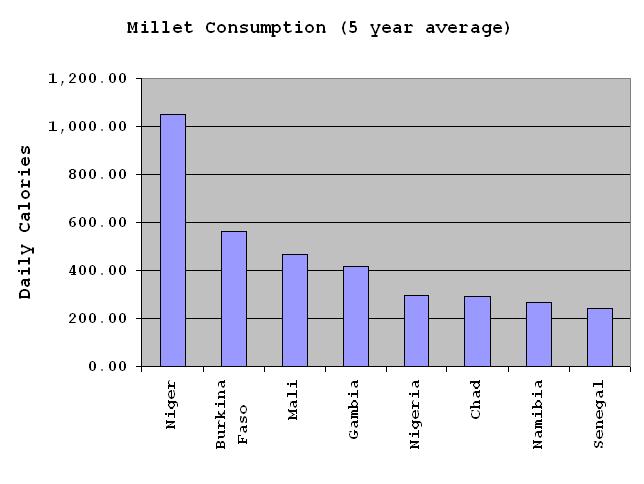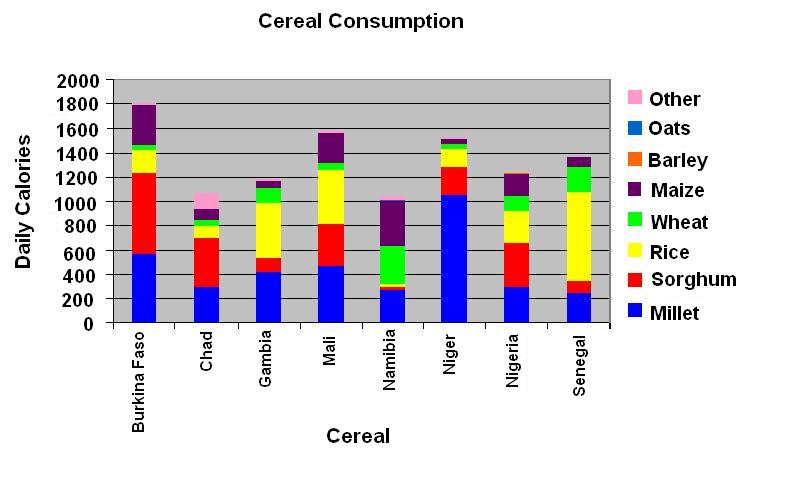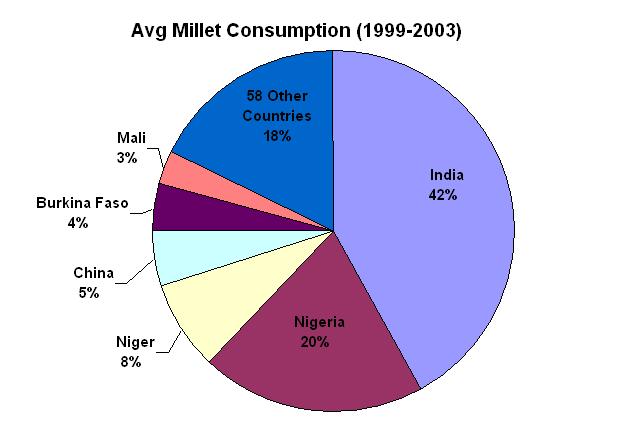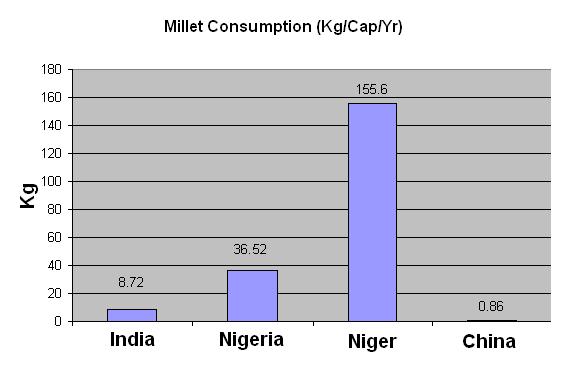![]() Species |
Rice |
Maize |
Wheat |
Barley |
Oats |
Foxtail Millet |
Pearl Millet |
Rye |
Sorghum |
Wild Rice |
Brachypodium |
Oryza Species |
Grape |
Arabidopsis
Species |
Rice |
Maize |
Wheat |
Barley |
Oats |
Foxtail Millet |
Pearl Millet |
Rye |
Sorghum |
Wild Rice |
Brachypodium |
Oryza Species |
Grape |
Arabidopsis
Note - because all different millets are grouped together for statisitic purposes the Foxtail Millet and Pearl Millet nutrition and statistics pages are similar or the same.)
Figure 1* |
Figure 2*  |
| Millets are a significant dietary food for one-third of the world population, including people in Asia, the Russian Federation, and Africa (9, 17). Based on a 5-year average (1999-2003*) eight countries depend on millet to provide over 200 calories a day, with half of those countries getting more than 400 calories a day from millet (see Figure 1*). Citizens of Niger rely on the staple food millet for over 1,000 daily calories (2). Looking at the top eight millet-consuming countries, we can compare their per-capita daily consumption of calories (5-year average) from all grains (see Figure 2*). | |
|
Millets are a large part of the basic diet for farm households in the world's poorest people in the poorest countries (4). To the right (Figure 3*) is a table of all the countries that consumed atleast 100,000 Metric Tonnes of millet on average for the past 5 years. Top consuming countries are identified in Figure 4*, including the top four countries: India, Nigeria, Niger and China. However, just because a country is a top global consumer does not mean that millet is a significant source of calories for them. India and China are rank as the #1 and #4 consumers of millet, but due to their population size they rank 11th and 38th in per-capita consumption, accordingly.* [Finger] millet is an excellent dietary source of calcium, iron, manganese, and methionine -- an amino acid lacking in the diets of hundred of millions of the poor who live on starchy foods such as cassava, plantain, polished rice, and maize meal (4). Millet use is diverse, including in cereals (including porridge and kasha), soups, breads and stuffings, fermented beverages, and baby food (9). |
| ||||||||||||||||||||||||||||||||||||
 |
 | ||||||||||||||||||||||||||||||||||||
Millet provides many nutrients (15% protein) and has a sweet nutty flavor (9), but may be associated with poor iodine uptake (as are many other common foods). But, this is generally not a "cause for alarm," as it is also considered to be one of the most digestible and non-allergenic grains available and there seems to be more benefits than risks in consuming this grain - for more indepth information, see (9).
| Calories | 286 | Carbohydrate (g) | 57 |
| Total fat (g) | 2.4 | Cholesterol (mg) | 0 |
| Saturated fat (g) | 0.4 | Sodium (mg) | 5 |
| Monounsaturated fat (g) | 0.4 | Thiamin (mg) | 0.3 |
| Polyunsaturated fat (g) | 1.2 | Niacin (mg) | 3.2 |
| Dietary fiber (g) | 3.1 | Magnesium (mg) | 106 |
| Protein (g) | 8 | Zinc (mg) | 2.2 |
Data from wholehealthmd.com